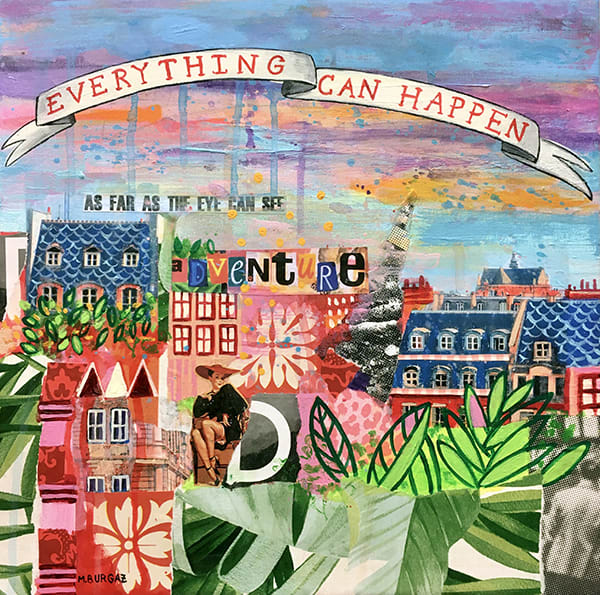Artful Encounters: Explore Madrid's Hidden Galleries With Artist María Burgaz
Q&A With María


Q: Could you share with us what initially drew you to the world of art and what motivates you to continue creating?
María: My passion for art goes back to my childhood. Since I was a child, my leisure time was always spent drawing and painting. I was lucky that my parents and family encouraged my hobby and have supported me to continue along a path that has not always been easy. Today, being an artist is a necessity that I cannot do without.
Q: What have been some of the biggest influences on your artistic style and approach?
María: There have been many influences in my artistic life and there still are. First, you admire your older brother's drawings, then those of your teacher and then you start to see paintings by masters that leave you open-mouthed and make you want to dedicate yourself to art. Artists like Velázquez, Matisse, Picasso, Mondrian... the list is long; but also many lesser-known artists that I discover in exhibitions inspire me and above all push me to continue with the determination that I am on the right path.
Q: Can you describe what guests can expect from the Hidden Art Gallery and Artists' Studios Tour? What makes this experience unique in Madrid?
María: The art offered in Madrid is getting bigger and better every day. Our museums are known and admired worldwide and many people travel just to see them. This offer is joined by a network of art galleries of the highest level that exhibit the best art that is currently being made in the world. For art lovers or people who want to be introduced to contemporary art, this experience is an approach to this exciting world that today transforms neighbourhoods and cities. It is an approach to places almost always unknown to tourists and that gives a totally new vision of Madrid. Strolling through the Salesas neighbourhood is already an experience and the final point in the studio of an artist in the traditional neighbourhood of Chamberí is the finishing touch to an activity that goes out of the typical tourist framework and discovers a more real Madrid.

Q: How do you select the galleries and artists' studios featured in the tour? What criteria must they meet?
María: The selection of art galleries to be visited is made according to their quality in the first place, and I also try to have a diversity of styles and proposals, which in the end is a reflection of the current contemporary art scene. Sometimes it is necessary to adapt to the schedules and calendars of the galleries, but the truth is that it is difficult to discard some exhibitions due to the big offer.
Q: Your work often includes a mix of painting, photographs, and other media. How do you choose which medium to use for a particular piece?
María: My work often includes a variety of techniques that coexist, complement and feed each other. When I face a painting, the idea from which I start often changes, and it is that struggle, that dialogue with the painting that makes me decide to include a new technique or material. The variety of textures, sheens, and materials provide a material richness that in turn coexists and complements the story of each work. There is no set process, each painting is a new battle, and that's what makes each day's work exciting.
Q: You mention using family photographs and those found in magazines in your artwork. Can you elaborate on how these elements integrate into your creations and the narratives they tell?
María: For me, photographs are stories in themselves; I know the history of some, and of others I simply imagine them, invent them. Old photos have a power and importance that has changed today. Let's bear in mind that having a photo taken was an event that not everyone had access to, it was a record of a life in a much more profound way than today. That is why including these pieces of history at a time when images are constant offers a different, nostalgic reading that is also a tribute to previous generations.

Q: You offer a unique art-buying experience that includes dinner surrounded by your works. What inspired this idea, and what has been the response from your guests?
María: This idea came almost by itself, it was like the finishing touch that the route needed to be able to digest and recapitulate all the stimuli experienced. After an intense walk seeing and assimilating so much art, people want to sit down, rest, and comment on everything, while continuing in an artistic environment. There is nothing better than a tasting of traditional products in such a unique setting. The idea of spending a longer period of time with works of art can encourage people to buy, and those who take their artwork with them never regret it.
Q: How do you believe the setting of a meal and discussion enhances the connection between the art, the artist, and potential buyers?
María: Art is a mystery and that is what makes it fascinating. There is no absolute truth and many points of view can be offered on the same work. Talking about art, about a painting, makes us forget about our everyday life, our problems, and our routine, it opens our minds and opens up a new world. The conversation with the artist opens the window to her world, to her moments of solitude while she creates and the perception that other people have of that final work. A buyer discovers that by having a work of art in their home they will not only "decorate" it, they will be able to lose themselves in it in their own homes.
Q: Madrid is a city known for its rich art scene. In what ways does living and working in Madrid influence your artwork and your professional journey as an artist?
María: The artistic offer in Madrid is enormous and often difficult to cover, there are so many things happening at the same time that some of them slip through the cracks due to lack of time. I am thankful every day to be able to live and work in Madrid, a city I love. The city inspires me and of course, seeing art always makes me want to make art. Since I was a child the Prado Museum was the best refuge and today also so many other museums, exhibitions, and events give me that push, that longing and that need to lock myself in my studio and create. There are no weekends or holidays when I am in my studio, time flies and Madrid is still waiting for me with all it has to offer.
Q: Can you share how the local culture and the city's artistic heritage have shaped your professional path?
María: As I have mentioned, living in Madrid and having the Prado Museum nearby has been a luxury. Admiring such modern artists as Velázquez, Goya, Zurbarán, Bosch... has been a luxury that I have enjoyed since I was a child and I never get tired of it. In addition, I have always lived in the shadow of another great museum, Sorolla, which is the dream paradise for any artist. Having these great masters in mind is always an incentive.
Q: Looking ahead, what new projects or exhibitions are you excited about? Are there new themes or approaches you are eager to explore?
María: I think it's clear that I love Madrid, and Spain, but I also love and need to travel and see new things. Every year I travel somewhere from where I bring back new ideas and inspiration. My trip to Turkey last year still has me making a series dedicated to its wonderful tiles, and now that I've just arrived from Poland something is sure to come up when I recap all my memories and documentation. I also like photography and I am working with all my photos to deepen the series of digital works I started during the confinement. And I don't want to forget the three-dimensional works with wood that I have started and that I want to continue to develop...


Q: How do you see your art evolving in the next few years, and what impacts do you hope to achieve through your work?
María: The projects I work on never end, because they come and go with new ideas as new ones emerge. The years go by too quickly and I hope to be able to continue advancing in my small discoveries, hoping that other people can enjoy them. I believe that art helps people and therefore society, I hope that my work is a grain of sand to make someone's life a little happier.
Q: What advice would you give to young artists just starting out, especially those looking to make a mark in a city as vibrant and competitive as Madrid?
María: The art world is difficult, artists just want to create, but there are also bureaucratic and day-to-day aspects that we have to deal with. We must not let this "dark side" get the better of us. The art world is not a competition and everyone can find their place, and a big city like Madrid always offers more opportunities. My advice is always honesty, don't let yourself be carried away by fashions or trends but by what you want to express. You have to listen and think about criticism but always being true to yourself.
Q: Are there common challenges you see emerging artists facing today, and how would you advise them to navigate these?
María: For me, who studied Fine Arts many years ago in a more traditional way, the challenge for many artists is to make compatible the new technologies that many incorporate immediately into their works with the study and knowledge of more "traditional" art. I think it is very important to know, study, and above all understand not only what is close to us but especially what seems distant and different.
Curated for You
You Might Also Like





